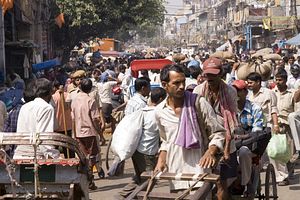Prime Minister Narendra Modi’s fascination with Hindi as India’s “official” language has irked several non-Hindi speaking states. Even though the idea of a standard national language is not new and has been toyed with by several countries in the past, India’s lack of homogeneity in this regard has been its greatest achievement. There are international lessons that can be drawn that show the superimposition of one regional language over the other as being counterproductive to national coherence: an obvious example can be found in India’s immediate neighborhood, Pakistan.
In November 1954, Pakistani leaders envisaged an ingenious plan to unite the country’s disparate territories on India’s Eastern and Western frontiers. The Western part, current day Pakistan, was a concoction of the Punjabi-dominated Punjab Province, the Sindhi-dominated Sindh, the Baloch territory of Baluchistan, and the unruly North-West Frontier Province, dominated by the Pathan (Pashtun). Meanwhile, the Eastern part, present day Bangladesh, was a predominantly ethnic Bengali territory. Even though all territories were overwhelmingly Muslim, their peoples were fiercely diverse.
Facing challenges in managing such a diverse swath of territory in a country that was built on the basis of religion, the Pakistani leadership of the time vehemently believed that religion was perhaps the only factor that united the new country. With this belief, under Prime Minister Muhammad Ali Bogra, then army chief General Ayub Khan (a Pashtun) and minister of the Interior, Ishkandar Mirza (a Bengali) devised a plan to achieve collectivity in East and West Pakistan. The plan, called “The One Unit Program” was to be the blueprint of modern Pakistan. It sought to bring about unity among all citizens irrespective of their ethnicity. Based on the plan, Western Pakistan, with all its diversity, would be called West Pakistan, while the Bengali land in the east was to be called East Pakistan. Both regions were to be governed independently from two capital cities, Lahore (West Pakistan) and Dhaka (East Pakistan), which were to have equal elected assemblies, with the federal government positioned at a new national capital, Islamabad.
However, the plan did not work. The problem was that standardization also meant the standardization of language and culture. If the Ayub-Mirza plan was to be a genuine success, the people would have to speak a standard language and practice a common cultural system. The Pakistani leaders believed that they could do for Pakistan what Mustafa Kemal Ataturk did for Turkey. However, the Pakistanis forgot one simple fact: the Turks were not only predominantly Muslim but were also culturally homogenous (at least after the break-up of the Ottoman Empire). In contrast, the new country of Pakistan was not culturally and ethnically homogenous in any way. The One Unit program slowly but steadily forced the dominant Punjabified Urdu language and culture onto the rest of the country, and problems began to erupt from there. The Bengalis and Balochs were the first to be offended by this blatant destruction of their indigenous cultural in the name of unity, and independent factions soon took to the streets. After the 1970 elections, power sharing agreements between the West and East political forces failed miserably. Subsequent armed oppression by the military led the resurrection of the independent rebel army, Mukti Bahini in East Pakistan. The rest, as we know, is history.
India inherited the same unmanageable diversity (indeed, even more so) that Pakistan did, but fortunately it never saw diversity as a curse. Instead, the modern secular Indian Constitution incorporated all ethnicities, to the extent that it identifies and recognizes 22 different languages in order to represent all Indians. B. R. Ambedkar, the architect of the Constitution, was focused on achieving equality for all cultures among a diverse citizenry.
India probably survived because the country never tried to enforce anything like One Unit Program; however, for a country where the language changes every 100 miles that might not be workable forever. One thing about Narendra Modi’s insistence on Hindi: he has identified language as the chief problem of managing such a diverse country. It is one reason why China has promoted Mandarin in Tibetan and Uyghur communities. The United States and Switzerland offer some interesting examples. The U.S. is also a country of diversity, yet the standard means of communication is English. The best part about the American system is that there is no real enforcement. In Switzerland, another unity in diversity model, English is widely used by advertisers to standardize communication because the country’s Italian, French and German speakers are too proud to speak each other’s languages. Apparently, the only language effective in communicating to such a diverse audience is the one that is native to none.
India, too, needs a means of communication that is standardized but does not offend anyone. The idea is not to take away the peculiar cultural diversity of India but to create a system where every Indian is on an equal footing through ease of communication. Chandra Bhan Prasad and Milind Kamble of the Dalit Indian Chamber of Commerce and Industry (DICCI) have consistently called for English to be India’s national language spoken by all, especially India’s dalits. If we look closely, there is a great deal of merit in what these gentlemen envisage for India. English is probably the only language that has no particular affinity to any particular community yet is widely spoken (or aspired to be spoken). In fact, India today has the largest English-speaking population in the world and the country’s economic rise is primarily because of this language.
In the case of Pakistan, the East Pakistanis felt humiliated when the language of their brethren in the west was enforced upon them. Had there been a language that had nothing to do with any particular stakeholder, things may have gone more smoothly. All stakeholders would have compromised and there would have been no cultural invasion. Surely India now has the same opportunity.
Karan Mehrishi is an economist and financial journalist based out of New Delhi

































